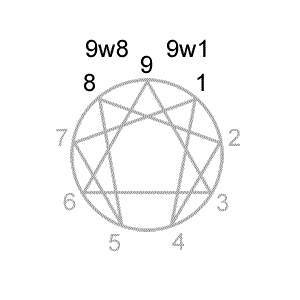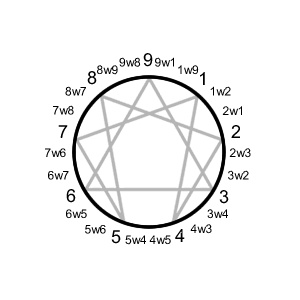Enneagram Wings: Influence from the adjacent personality types

The wings are represented by the two numbers on either side of an Enneagram type as seen on the Enneagram symbol. Generally, one wing will have more of an influence than the other. This is called your preferred wing or dominant wing.
For example, if someone who primarily identifies as type 9 also identifies more with type 8 than type 1 then they are said to be a 9 wing 8 (9w8). If that same person were to identify more with type 1 than type 8 then they'd be considered a 9 wing 1 (9w1).
Enneagram wings are most often used to describe two variations of a type.
Wing numbers of each type
1 wing 9 (1w9) - preferred 9 wing
Common Name: The Idealist
- more likely to keep the peace
- more emotionally reserved
- more impersonal and dispassionate
1 wing 2 (1w2) - preferred 2 wing
Common Name: The Advocate
- more easily expresses anger
- more responsive to others' needs
- more interpersonal and passionate
2 wing 1 (2w1) - preferred 1 wing
Common Name: The Servant
- more dutiful, of service
- more self-critical and unselfish
- more emotionally restrained
2 wing 3 (2w3) - preferred 3 wing
Common Name: The Host/Hostess
- more ambitous and goal oriented
- more attention seeking and image oriented
- more direct about what they want
3 wing 2 (3w2) - preferred 2 wing
Common Name: The Charmer
- more emotional and helpful
- more desirous of popularity and admiration
- more able to shift image as needed
3 wing 4 (3w4) - preferred 4 wing
Common Name: The Professional
- more serious and task-oriented
- more about producing and being competent
- more driven to attain or embody perfection
4 wing 3 (4w3) - preferred 3 wing
Common Name: The Aristocrat
- more ambitious and goal oriented
- more effort toward recognition and presentation
- more practical and competitive
4 wing 5 (4w5) - preferred 5 wing
Common Name: The Bohemian
- more defiant of convention
- more minimalistic and private
- more dwelling in their imagination
5 wing 4 (5w4) - preferred 4 wing
Common Name: The Iconoclast
- more imaginative than analytic
- deals more with symbolic representation
- more peaceful and going along
5 wing 6 (5w6) - preferred 6 wing
Common Name: The Problem-Solver
- more technically oriented
- deals more with factual details
- more contrary and argumentative
6 wing 5 (6w5) - preferred 5 wing
Common Name: The Defender
- more contrary and serious
- more dutiful and responsible
- more anti-authoritarian and reactionary
6 wing 7 (6w7) - preferred 7 wing
Common Name: The Buddy
- more self-deprecating and disarming
- more dependent upon others
- more eager to be liked and have fun
7 wing 6 (7w6) - preferred 6 wing
Common Name: The Entertainer
- more playful and optimistic
- more concerned with being liked
- more sensitive and agreeable
7 wing 8 (7w8) - preferred 8 wing
Common Name: The Realist
- more practical and realistic
- more aggressive in getting needs met
- more direct and opinionated
8 wing 7 (8w7) - preferred 7 wing
Common Name: The Independent
- more active and goal oriented
- more aggressive and competitive
- more impatient and impulsive
8 wing 9 (8w9) - preferred 9 wing
Common Name: The Bear
- more laid-back and grounded
- more reserved and steady
- more prone to comfort and routine
9 wing 8 (9w8) - preferred 8 wing
Common Name: The Referee
- merges more with their surroundings
- can have angry outbursts then forget
- wants to keep things comfortable
9 wing 1 (9w1) - preferred 1 wing
Common Name: The Dreamer
- filters for the consensus opinion
- more reserved and less adventurous
- more of an observer and thinker
Why the two types on either side?
Each Enneagram type is said to be a product of the types on either side. For example type 9 can be understood as being caught between types 8 and 1.
Type 8 is about making things happen in the external world, getting things moving. Type 1 is about doing things in a way that aligns with an internalized sense of correctness. Type 9 can have difficulty or confusion with initiating movement on their own, a struggle between external and internal motivations for action. As a result, the tendency is often to just go along with what's happening around them, either resolving that struggle at a later time or simply disregarding it.
Because it's the types on either side that have this influence, the term "wings" was used to reference these two adjacent types.
The preferred wing is NOT your secondary type
People new to the Enneagram types sometimes assume that their wing is the second most influential type.
They might take a test that ranks the types from highest to lowest score. While the highest scoring type is likely their primary type they might assume that the next highest score is their wing type.
For example, someone might have type 9 as their highest score and type 5 as their second highest score and assume they're a type 9 with a 5 wing (9w5).
The problem with that assumption is that the wing is NOT your secondary type. The wing is a variation of your primary type. You don't look at the second highest score, you compare the scores of the wing types instead.
Both wing types have an influence
While your preferred wing will have more of an influence than the other wing, both wings have an influence to some degree.
Some say that you develop both wings over your lifetime to the point that your wings become more balanced.
Wings don't work for everyone
The point of the wings is to gain a more nuanced understanding of your type. It's not to force fit you into a category.
Like many other concepts with the Enneagram types, if you find wings useful then use them. If not then don't.
How do I find my wing?
You can start with a test to find which of the two wings you prefer more then follow up by reading more about each wing type to see if that preference holds true for you.
You may find that you associate with neither wing or you may find that you identify with both wings equally. If so, then the wing concept may not be of much use to you.
Enneagram Tests to Help Determine Wing

The wing types of an Enneagram type are the types on either side of a type as seen on the Enneagram symbol.
Although both the wing types have an influence on the type between them, one wing type is often preferred over the other.
This preferred wing type has a stronger influence than the non-preferred wing type and creates a variation of the type (e.g., 9w8 vs. 9w1).
-
Enneagram Type with Wing Test
This is a very short test that determines your most likely type and preferred wing.
Select from paragraphs, similar to the method used by the
Essential Enneagram Test as found in The Essential Enneagram book.
Use when you want to know your type and preferred wing. -
Enneagram Type Preference Test
This test produces a scored list of all nine types.
Questions are forced-choice, similar to the method used by the Riso-Hudson Enneagram Type Indictor (RHETI).
Use to determine type, wings, gut/heart/head types, and tri-center. -
Enneagram Wing Comparison Test
This test compares the two wings of any type, producing a score for each wing.
Use when you know your type but not your preferred wing. -
Enneagram Type Comparison Test
This test compares any two types, producing a score for each.
Use when not sure which of two types is your primary type and which is your preferred wing type.
Click here for the Complete Guide to the Enneagram.
This free guide explains- the nine Enneagram personality types
- the many type variations within type
- where the types came from (origins and history)
- how the types use the Enneagram symbol
Click here for Enneagram tests.
These free tests help you find your- primary type
- candidate types
- preferred wing
- intinctual subtype
- instinctual variant stacking
- center types (gut, heart, and head)
- tri-center with wings